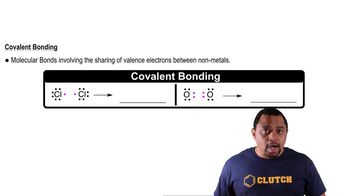Here are the essential concepts you must grasp in order to answer the question correctly.
Covalent Bonds
Covalent bonds form when two atoms share one or more pairs of electrons, typically between nonmetals. This sharing allows each atom to attain a stable electron configuration, often resembling that of noble gases. For example, in a Cl-F bond, both chlorine and fluorine are nonmetals that share electrons, resulting in a covalent bond.
Recommended video:
Ionic Bonds
Ionic bonds occur when one atom donates an electron to another, resulting in the formation of charged ions. This typically happens between metals and nonmetals, where the metal loses electrons and becomes positively charged, while the nonmetal gains electrons and becomes negatively charged. For instance, in the Rb-F bond, rubidium (a metal) donates an electron to fluorine (a nonmetal), creating an ionic bond.
Recommended video:
Electronegativity
Electronegativity is a measure of an atom's ability to attract and hold onto electrons in a bond. The difference in electronegativity between two atoms helps determine the type of bond formed: a large difference typically indicates an ionic bond, while a small difference suggests a covalent bond. For example, the electronegativity difference between Na and S indicates that they will form an ionic bond, while the difference between N and S suggests a covalent bond.
Recommended video:
 Verified step by step guidance
Verified step by step guidance


